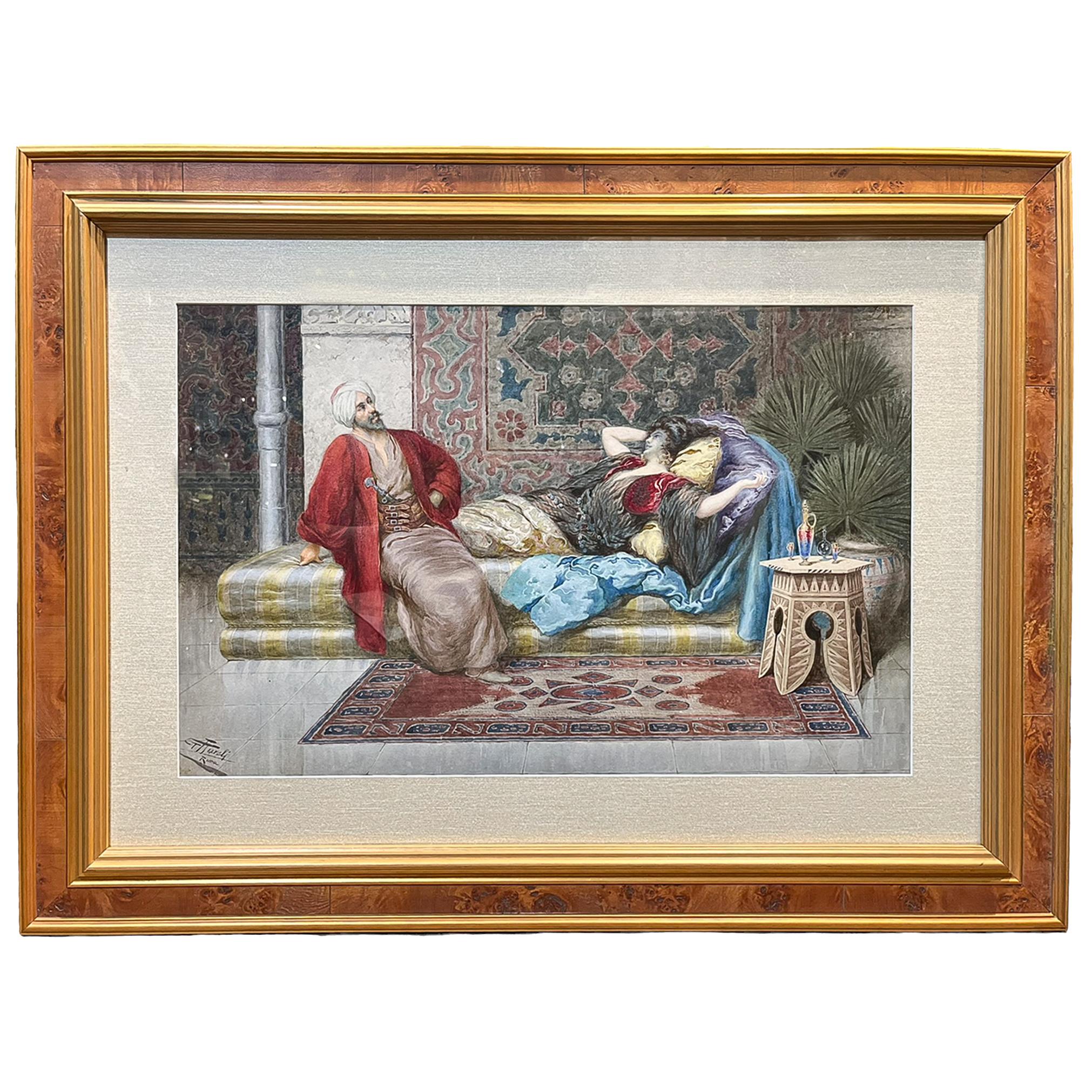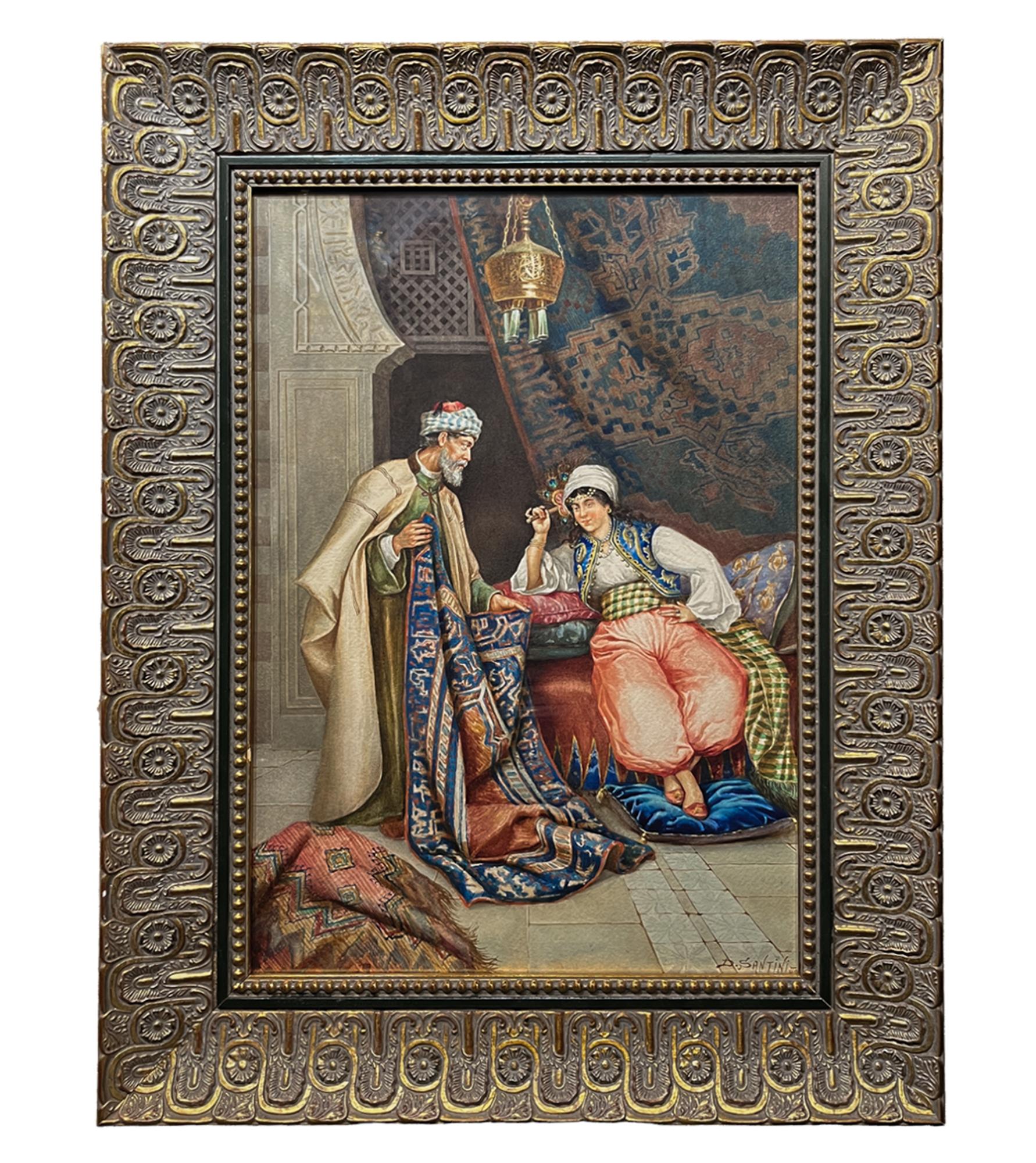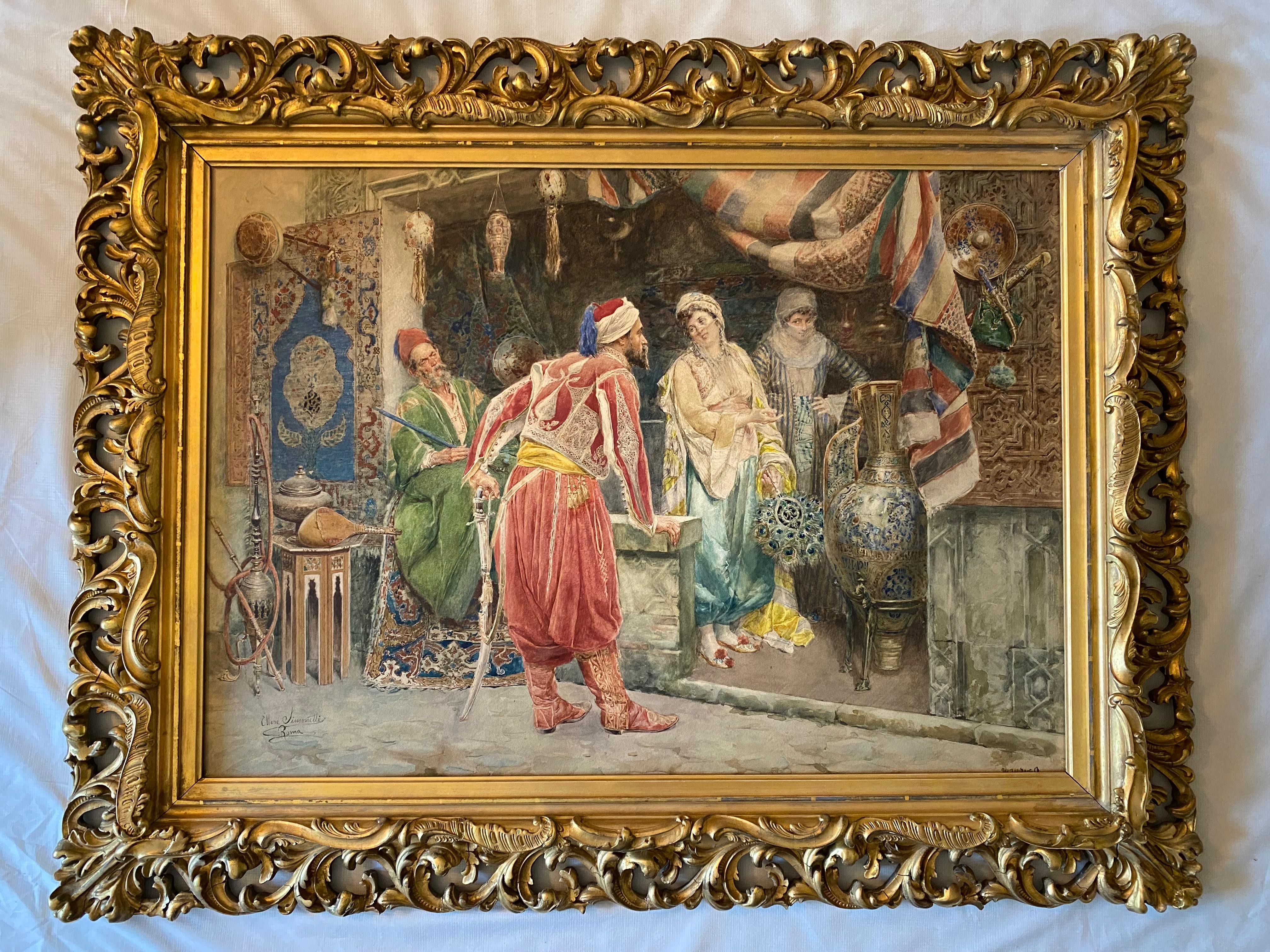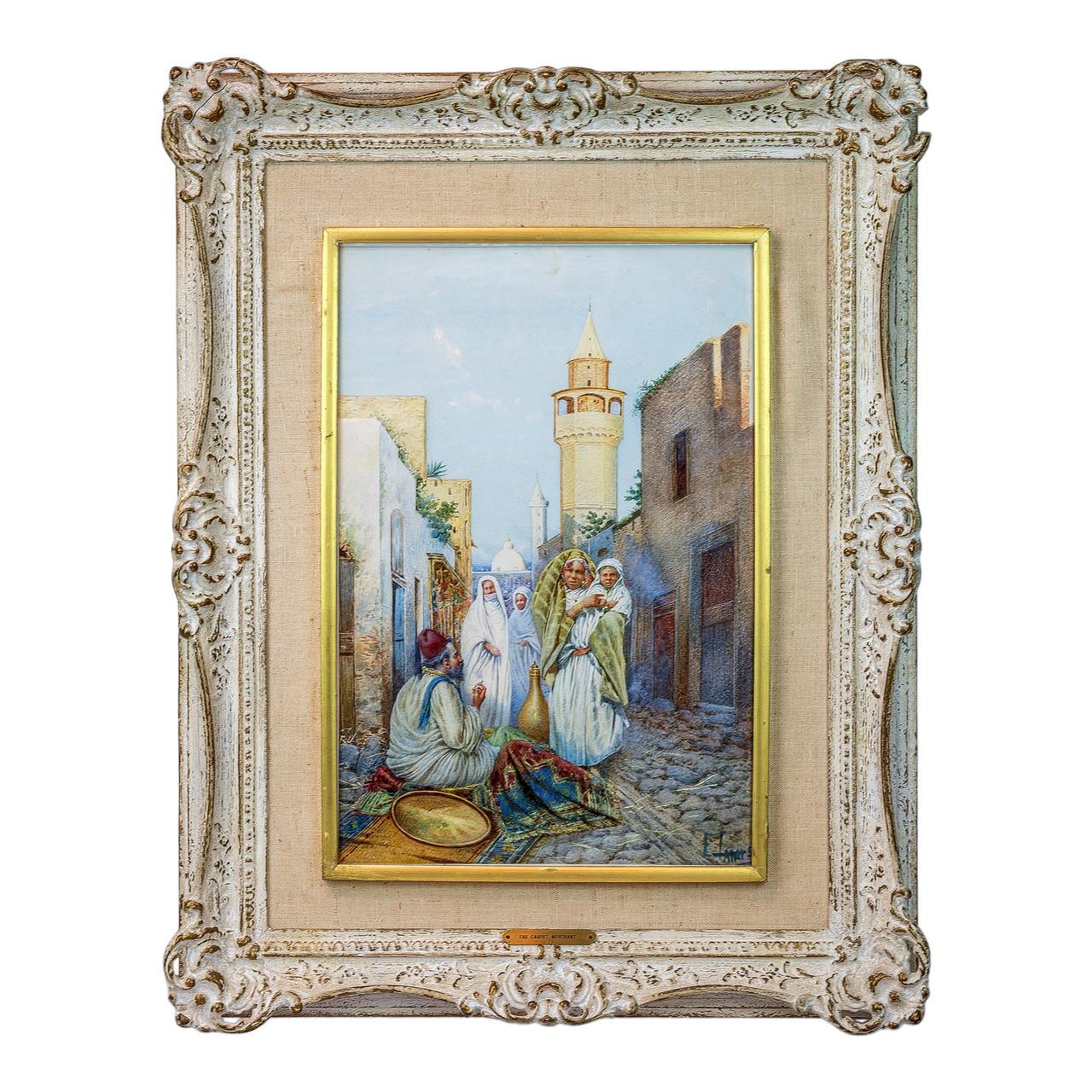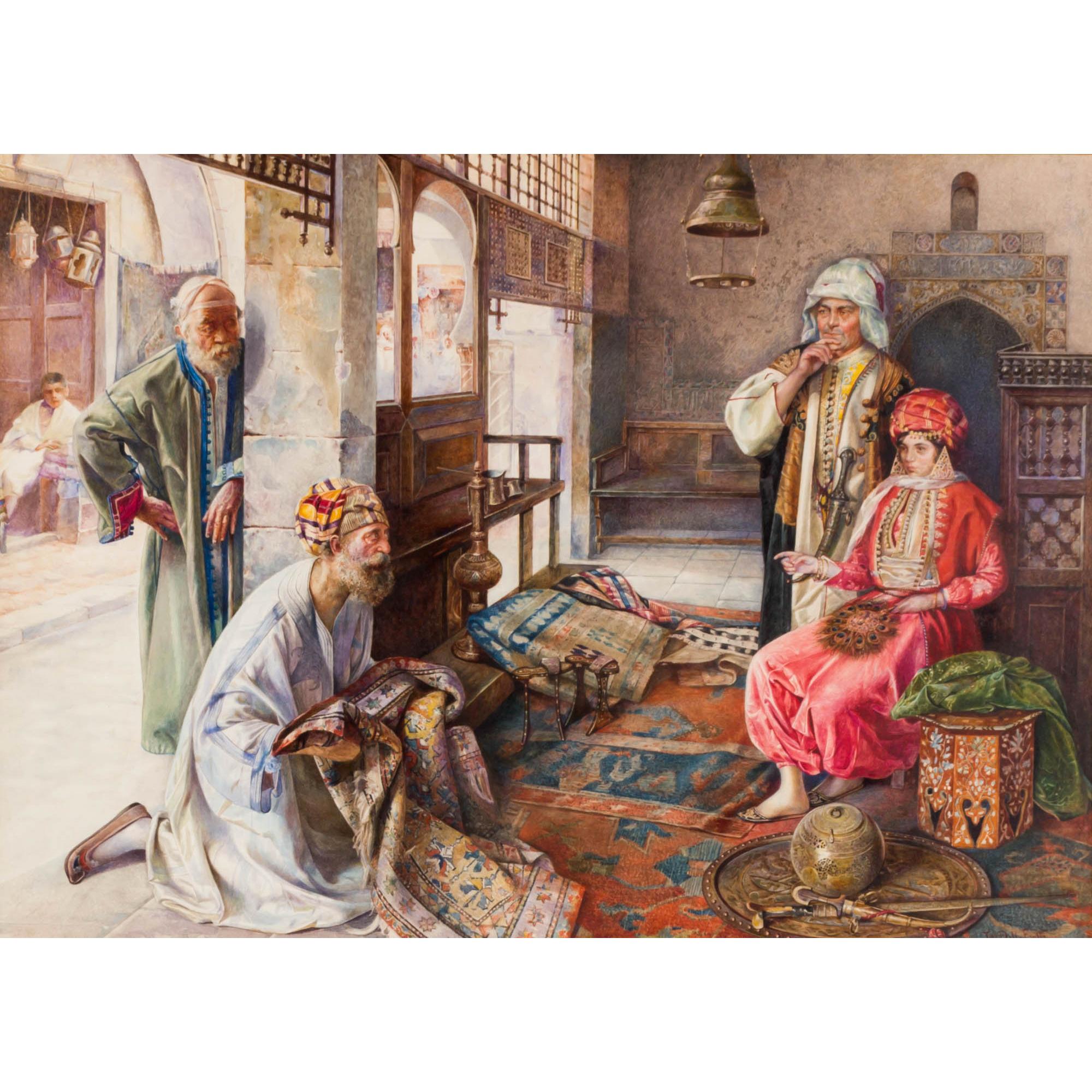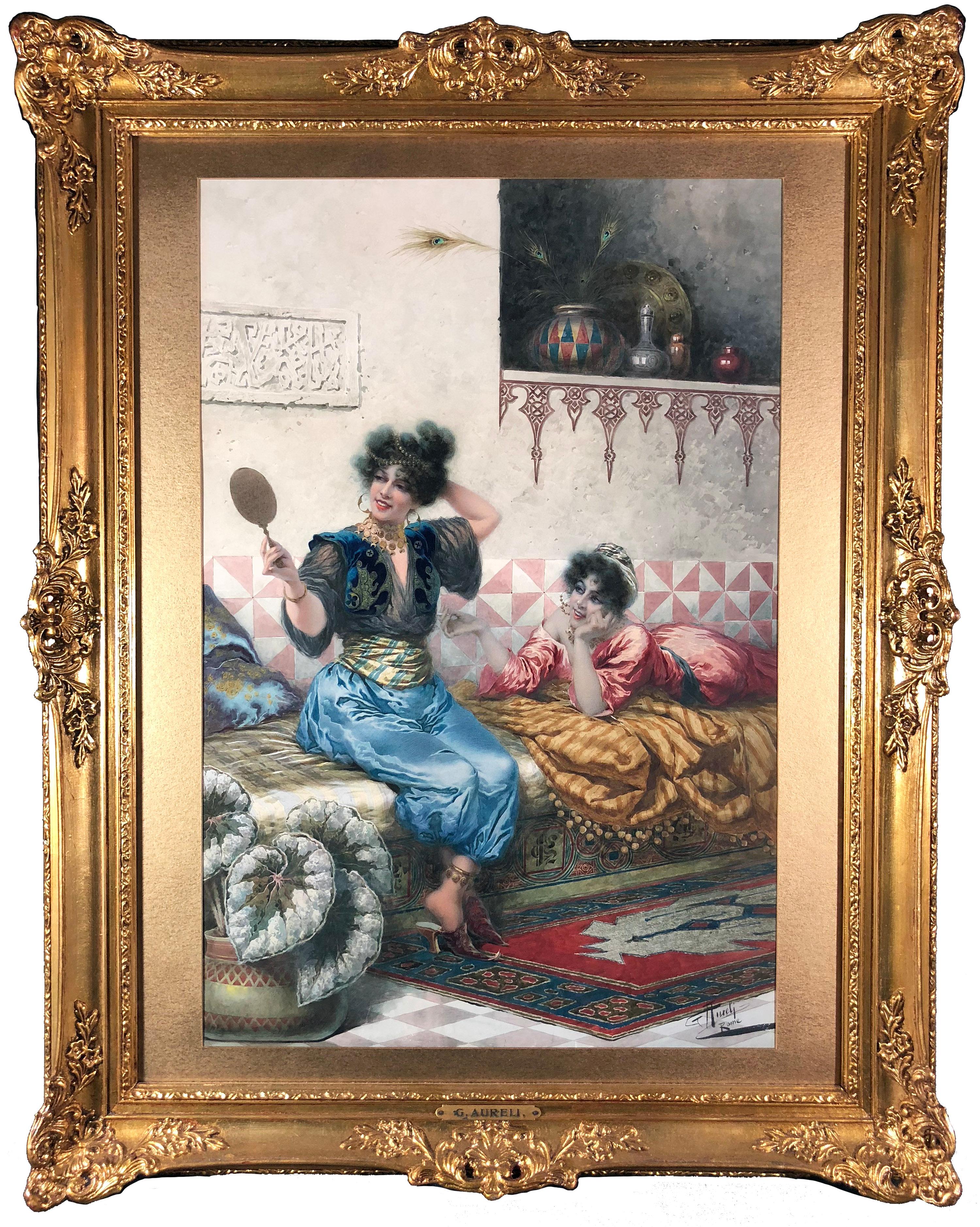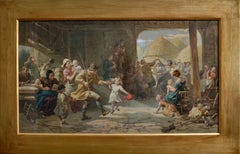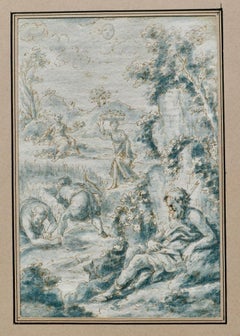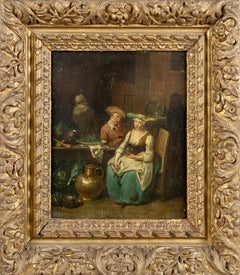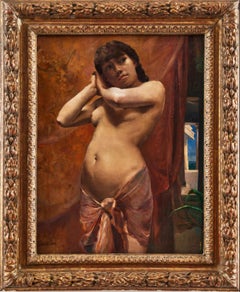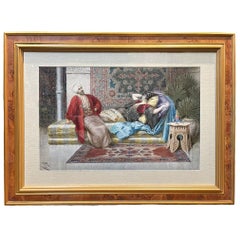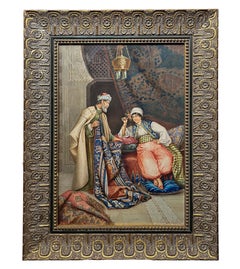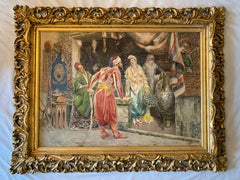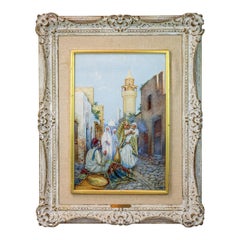Items Similar to Harem Scene with Musician and Monkey
Want more images or videos?
Request additional images or videos from the seller
1 of 16
Cleto LuzziHarem Scene with Musician and MonkeyEarly 20th Century
Early 20th Century
$3,831.12
£2,842.71
€3,200
CA$5,350.73
A$5,803
CHF 3,047.96
MX$70,487.64
NOK 38,140.34
SEK 35,911.26
DKK 24,368.02
About the Item
Cleto Luzzi (1884–1952)
“The Wandering Musician” signed by Cleto Luzzi (1884–1952), a watercolor on paper depicting an Orientalist scene of a musician with his instruments and a small monkey clashing cymbals, entertaining two reclining women in a harem interior. One woman lies on a leopard skin, the other rests on a divan. The composition combines theatrical exoticism with refined academic draftsmanship, characteristic of Luzzi’s decorative and narrative sensibility.
Cleto Luzzi was born in Rome in 1884 and died in 1952. He trained at the Istituto di Belle Arti in Rome under Francesco Jacovacci and Giulio Aristide Sartorio, inheriting from them both the discipline of academic realism and the decorative, monumental vision typical of late 19th-century Italian painting.
Early in his career, Luzzi produced genre paintings and Rococo-inspired watercolors marked by a delicate, affectionate tone. From Sartorio he learned fresco and large-scale decorative technique, which he applied in numerous ecclesiastical commissions throughout Rome.
He decorated several Roman churches, including San Nicola de’ Prefetti, San Giuseppe a Capo le Case, San Claudio, Santa Maria Margherita Alacoque, and the Chapel of the Precious Blood (Cappella del Preziosissimo Sangue) at Verano. These works exemplify a polished, classically composed style aligned with early 20th-century sacred art in Italy.
Between 1929 and 1932, Luzzi served as Official Painter to the King of Siam (Thailand) and Director of the Royal Academy of Fine Arts in Bangkok. During this period he traveled widely in Southeast Asia — to Siam, Cambodia, India, Indochina, and Burma — and produced a series of Orientalist and landscape paintings. In these works his style became freer and more luminous, adopting a subtle Divisionist touch and refined coloration influenced by the eastern light. These works display a lyrical interpretation of temples, monuments, and local scenes, revealing both a fascination with the East and a continued attachment to Italian compositional balance.
After returning to Italy, Luzzi continued to paint and exhibit, gaining recognition for both his religious and Orientalist subjects. His work received public and ecclesiastical commissions and was shown in national exhibitions.
Cleto Luzzi was widely recognized in his lifetime. Following his death in 1952, retrospective exhibitions were organized in 1956 at the Palazzo delle Esposizioni and the Collegio Nazareno in Rome, and in 1958 at the Circolo di Forestieri in Sorrento.
Today, his religious works remain in situ in several Roman churches and are listed in Italian national heritage registries.
- Creator:Cleto Luzzi (1884 - 1952, Italian)
- Creation Year:Early 20th Century
- Dimensions:Height: 27.96 in (71 cm)Width: 37.01 in (94 cm)Depth: 1.58 in (4 cm)
- Medium:
- Movement & Style:
- Period:
- Condition:This watercolor is in good condition. Some insignificant fading, still with good colors. The original frame has a small damage to the right corner. We can arrange restoration of this area or a change to a new frame of your choice.
- Gallery Location:Stockholm, SE
- Reference Number:1stDibs: LU2608217020892
About the Seller
5.0
Platinum Seller
Premium sellers with a 4.7+ rating and 24-hour response times
1stDibs seller since 2023
28 sales on 1stDibs
Typical response time: <1 hour
- ShippingRetrieving quote...Shipping from: Stockholm, Sweden
- Return Policy
Authenticity Guarantee
In the unlikely event there’s an issue with an item’s authenticity, contact us within 1 year for a full refund. DetailsMoney-Back Guarantee
If your item is not as described, is damaged in transit, or does not arrive, contact us within 7 days for a full refund. Details24-Hour Cancellation
You have a 24-hour grace period in which to reconsider your purchase, with no questions asked.Vetted Professional Sellers
Our world-class sellers must adhere to strict standards for service and quality, maintaining the integrity of our listings.Price-Match Guarantee
If you find that a seller listed the same item for a lower price elsewhere, we’ll match it.Trusted Global Delivery
Our best-in-class carrier network provides specialized shipping options worldwide, including custom delivery.More From This Seller
View AllVillage Party - 19th Century Watercolor
Located in Stockholm, SE
A painted watercolor of joyous village festivity with music playing and dancing people by Walter Goodall, signed and dated 1862. In the foreground, a young girl in a white dress danc...
Category
1860s English School Figurative Drawings and Watercolors
Materials
Paper, Watercolor
Allegory of Summer - 17th Century Italian Sepia and Watercolor Drawing
Located in Stockholm, SE
A fine Italian watercolor and sepia drawing, an allegory of summer. People harvesting, eating and drinking in a hilly landscape, probably by Antonio Grano (c.1669-1718). In the fron...
Category
Late 17th Century Italian School Figurative Drawings and Watercolors
Materials
Paper, Ink, Watercolor
Kitchen Scene - 18th Century Oil on Panel
By Jan Baptist Lambrechts
Located in Stockholm, SE
A Kitchen Scene by Jan Baptist Lambrechts (Antwerp, 1680–1731)
The painting depicts a lively kitchen interior where a man, wearing a hat, raises a glass of red wine in a toast toward...
Category
Early 18th Century Flemish School Figurative Paintings
Materials
Oil, Wood Panel
Oriental Woman - 19th Century Oil on Canvas
Located in Stockholm, SE
A standing odalisque holding her hands together upwards against the side of her head. Behind her a drapery and to the right of her an opening towards a terrace with sunlit skies and ...
Category
1890s Other Art Style Figurative Paintings
Materials
Canvas, Oil
Italian School 18th Century Drawing - Red Chalk on Paper
Located in Stockholm, SE
An Italian red chalk drawing depiction on paper, probably 17th or 18th century, illustrating the dramatic scene of Polyphemus hurling a boulder at Acis and Galatea. Attributed to an...
Category
17th Century Italian School Figurative Drawings and Watercolors
Materials
Chalk, Paper
Coastal Landscape with Women Picking Flowers - 19th Century Oil on Panel
Located in Stockholm, SE
A fine small plein air study of three women picking flowers on the meadow next to white cliffs and sea. In the horizon where the sky ends, the contours of mainland is visible as a sh...
Category
Late 19th Century Naturalistic Landscape Paintings
Materials
Paper, Oil, Cardboard
You May Also Like
Giuseppe Aureli Orientalist Watercolor In The Harem .
By Giuseppe Aureli
Located in New York, NY
Middle Eastern Indoor Scene, watercolor of a man and a reclining woman.
Artist: Giuseppe Aureli (1858 - 1929)
Origin: Italian
Date: 19th Century
Medium...
Category
19th Century Other Art Style Interior Paintings
Materials
Watercolor
Dario Santini (Italian, 1874-1924) Rug Merchant watercolor .
Located in New York, NY
Dario Santini, an Italian painter born in Ancona in 1874, largely focused on subjects of the west in his practice, making an orientalist painting by him rather rare. Skillfully rendered in watercolor, a young man reclines in a stately home, fanning himself with a peacock feather fan...
Category
Late 19th Century Italian School Interior Paintings
Materials
Watercolor
La Visite Au Brocanteur
By Ettore Simonetti
Located in Los Angeles, CA
A magnificent Orientalist watercolor/gouache on paperboard depicting a market scene.
The work has incredible details and is in very fine condition.
Signed lower left along with Roma....
Category
1890s Italian School Figurative Drawings and Watercolors
Materials
Watercolor
Orientalist Watercolor Painting a Carpet Merchant by Eugene Louis Lami
By Eugène Louis Lami
Located in New York, NY
The Carpet Seller depicts a man in a domed Fez hat as he is approached by three women and a child. Middle eastern architecture floods the scene. The way the pa...
Category
19th Century Figurative Drawings and Watercolors
Materials
Watercolor
Tito Della Fralte Orientalist Watercolor The silk Rug .
Located in New York, NY
Title: Rug Merchant
Artist: Tito Della Fralte (20th C.)
Origin: French
Medium: Watercolor and pencil on paper
Dimension: 19 x 26 inches
Signed Tito Della Fralte and inscribed Roma (lr)
Category
Early 20th Century Portrait Drawings and Watercolors
Materials
Watercolor, Pencil
An Opulent Evening
By Guiseppe Aureli
Located in Missouri, MO
Guiseppe Aureli (1858-1929)
"An Opulent Evening" c. 1880s
Watercolor on Paper
Signed Lower Right
Site Size: approx. 30 x 20 inches
Framed Size: approx. 37 x 29 inches
Giuseppe Aureli (December 5, 1858 in Rome – 1929) was an Italian painter and watercolorist. His work is noted for its historical subject matter, portraits of Italian noble families as well as genre paintings and local scenes, especially work with Oriental themes.
He received his early art education at the Academia de San Luca where he was the pupil of Pietro Gabarini and Cesare Maccari.[1] He exhibited in various exhibitions; including: The International Exhibition of 1888 in Munich and the World Fair of 1893 in Chicago, but his Oriental works were rarely included in these early exhibitions. Having his workshop at 48 Via Margutta in Rome, Aureli was in a position to exchange ideas with the most prolific Orientalist artists at that the time. He used the same staircase that led to a rabbit-warren of studios including those of Filippo Bartolini, Enrico Tarenghi...
Category
Late 19th Century Victorian Figurative Drawings and Watercolors
Materials
Watercolor, Laid Paper
Price Upon Request
